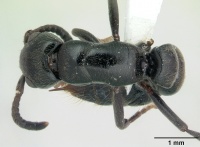Simopone trita
| Simopone trita | |
|---|---|
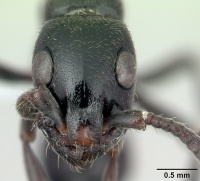
| |
| Scientific classification | |
| Kingdom: | Animalia |
| Phylum: | Arthropoda |
| Class: | Insecta |
| Order: | Hymenoptera |
| Family: | Formicidae |
| Subfamily: | Dorylinae |
| Genus: | Simopone |
| Species group: | emeryi |
| Species: | S. trita |
| Binomial name | |
| Simopone trita Bolton & Fisher, 2012 | |
Specimens have been collected from low vegetation, a rotten log, from dead twigs above the ground and as ground foragers in a variety of forest habitats.
Identification
A member of the emeryi species group. S. trita and Simopone dignita form a small complex of species that in Madagascar is morphologically intermediate between the silens and emeryi complexes. They combine the reduced pilosity of the latter with the stocky AIII and posteriorly shifted eyes of the former. The two species are easily differentiated by the characters noted in the key, but in addition the posterior margins of tergites AIII and AIV in trita have a few short setae at most, whereas in dignita these margins each have a fringe of distinct setae that are obviously curved towards the midline. (Bolton and Fisher 2012)
Keys including this Species
Distribution
Latitudinal Distribution Pattern
Latitudinal Range: -13.08333333° to -13.08333333°.
| North Temperate |
North Subtropical |
Tropical | South Subtropical |
South Temperate |
- Source: AntMaps
Distribution based on Regional Taxon Lists
Malagasy Region: Madagascar (type locality).
Distribution based on AntMaps
Distribution based on AntWeb specimens
Check data from AntWeb
Countries Occupied
| Number of countries occupied by this species based on AntWiki Regional Taxon Lists. In general, fewer countries occupied indicates a narrower range, while more countries indicates a more widespread species. |

|
Estimated Abundance
| Relative abundance based on number of AntMaps records per species (this species within the purple bar). Fewer records (to the left) indicates a less abundant/encountered species while more records (to the right) indicates more abundant/encountered species. |

|
Biology
|
Castes
Worker
Images from AntWeb
 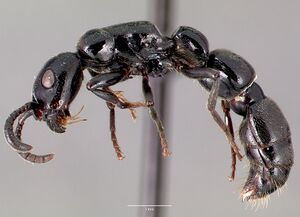  
| |
| Worker. Specimen code casent0410474. Photographer April Nobile, uploaded by California Academy of Sciences. | Owned by CAS, San Francisco, CA, USA. |
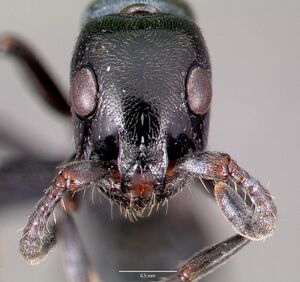 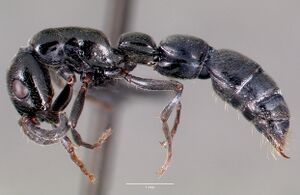 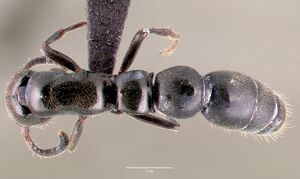 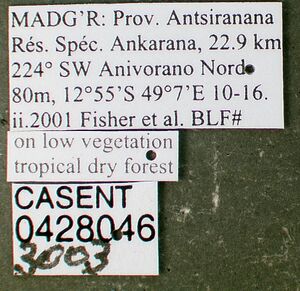
| |
| Worker. Specimen code casent0428046. Photographer April Nobile, uploaded by California Academy of Sciences. | Owned by CAS, San Francisco, CA, USA. |
   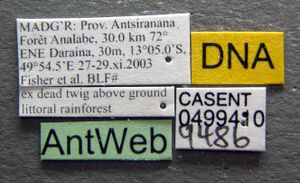
| |
| Holotype and paratype of Simopone trita. Worker. Specimen code casent0499410. Photographer April Nobile, uploaded by California Academy of Sciences. | Owned by CAS, San Francisco, CA, USA. |
Nomenclature
The following information is derived from Barry Bolton's Online Catalogue of the Ants of the World.
- trita. Simopone trita Bolton & Fisher, 2012: 66, figs. 73-75 (w.) MADAGASCAR.
- Type-material: holotype worker, 10 paratype workers.
- Type-locality: holotype Madagascar: Prov. Antsiranana, Forêt Anlabe, 30.0 km. 72° ENE Daraina, 30 m., 13°05.0’S, 49°54.5’E, 27-29.xi.2003, BLF9486, CASENT0499410, ex dead twig, above ground, littoral forest (B.L. Fisher); paratypes: 2 workers with same data, 2 workers with same data but CASENT0499410-RES, 3 workers with same data but CASENT0499411, 3 workers with same data but CASENT0499412.
- Type-depository: CASC.
- Distribution: Madagascar.
Unless otherwise noted the text for the remainder of this section is reported from the publication that includes the original description.
Description
Worker
(holotype in parentheses). HL 1.56–1.94 (1.68), HW 1.14–1.46 (1.26), SL 0.54–0.68 (0.56), EL 0.44–0.55 (0.50), PW 0.95–1.16 (1.02), AIIW 0.91–1.18 (0.98), AIIL 0.85–1.06 (0.90), AIIIW 1.09–1.38 (1.17), AIIIL 1.00–1.22 (1.04), WL 1.82–2.20 (2.00), MFL 1.12–1.46 (1.18), CI 73–79 (75), SI 44–48 (44), EL/HW 0.36–0.40 (0.39), EP 1.15–1.55 (1.48), AIIW/AIIL 1.07–1.18 (1.09), AIIIW/AIIIL 1.06–1.19 (1.12) (15 measured).
In full-face view anteriormost points of frontal lobes are slightly posterior to the level of the midpoint of the convex anterior clypeal margin. Eyes located behind the cephalic midlength (EP 1.15–1.55). Leading edge of scape with 3–5 projecting setae that are curved or inclined toward the scape apex. In full-face view sides of head in front of eyes often with one or two projecting short setae, but behind eyes only with minute pubescence that is appressed or very nearly so. In profile frontal carinae with relatively long setae and cephalic dorsum with 2–3 standing short setae above the eye, and usually also with a very few setae that are located more posteriorly. Cephalic dorsum between eyes densely punctate, the punctures adjacent or nearly so. Anterior and dorsal surfaces of pronotum separated by an angle or weak margination, but without a strongly defined carina. Propodeal dorsum meets declivity through a blunt angle, without a transverse carina. Promesonotal suture weakly impressed; metanotal groove vestigial to absent. Mesosoma in dorsal view very obviously narrowest across mesonotum, much broader across pronotum and propodeum (in holotype PW 1.02, maximum width across mesonotum 0.80, maximum width across propodeum 1.00). Dorsum of mesosoma densely finely punctate everywhere. Mesosoma with a single pair of short setae, close to the pronotal humeri (easily abraded away, missing from holotype); mesosoma otherwise without setae but entire dorsum with appressed pubescence. Dorsal (outer) surfaces of mesotibiae and metatibiae mostly without projecting setae but one or two usually present close to their apices. Dorsal surface of AII (petiole) meets anterior surface in a fine transverse carina. Posteriorly the dorsum of AII lacks a sharp carina but a weak, arched ridge is present above the foramen. In dorsal view the posterior corners of AII are extended into stout triangular teeth that project posterolaterally. Lateral surface of AII, below the dorsolateral margin and above the level of the spiracle, with a longitudinal ridge or carina that extends the length of the sclerite. In dorsal view AII and AIII distinctly broader than long; AIV also broader than long. Abdominal tergites from AII to AIV often without setae, but a few may be present along the extreme apical margins of AIII and AIV; all three segments with quite dense, greyish appressed pubescence. Setae distinct on sternites of AIII and AIV. Abdominal tergites AII to AIV sculptured only with small punctures. Full adult colour black, appendages blackish brown to black; clypeus usually dull reddish; sides of pronotum and sides of abdominal tergites AIII and AIV often with a dull reddish spot, but this is variably developed and may be inconspicuous or absent on any sclerite.
Type Material
Holotype worker (top specimen of three on pin), Madagascar: Prov. Antsiranana, Forêt Anlabe, 30.0 km 72° ENE Daraina, 30 m, 13°05.0’S, 49°54.5’E, 27–29.xi.2003, BLF9486, CASENT0499410, ex dead twig, above ground, littoral forest (B.L. Fisher) (California Academy of Sciences). Paratypes. 2 workers on same pin, below holotype; 2 workers from same series as holotype but labelled only BLF9486, CASENT0499410-RES; 3 workers with same data as holotype but CASENT0499411; 3 workers with same data but CASENT0499412 (CASC).
References
- Bolton, B. & Fisher, B.L. 2012. Taxonomy of the cerapachyine ant genera Simopone Forel, Vicinopone gen. n. and Tanipone gen. n. (Hymenoptera: Formicidae). Zootaxa, 3283, 1–101.
- Borowiec, M.L. 2019. Convergent evolution of the army ant syndrome and congruence in big-data phylogenetics. Systematic Biology 68, 642–656 (doi:10.1093/sysbio/syy088).
References based on Global Ant Biodiversity Informatics
- Bolton B., and B. L. Fisher. 2012. Taxonomy of the cerapachyine ant genera Simopone Forel, Vicinopone gen. n. and Tanipone gen. n. (Hymenoptera: Formicidae). Zootaxa 3283: 1-101.

